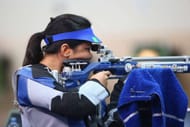Of the 12 sporting disciplines that India will be competing in at the upcoming Rio 2016 Summer Olympic Games in August, the sport of Shooting probably gives India’s sports fans the most hopes of a medal. In fact, there seems to be an air of certainty around it, something not enjoyed thus far by any Indian sports squad headed for the quadrennial sporting extravaganza, post the golden days of Indian hockey which lasted till the 80s. And that was a good three decades ago.
So what has brought the Indian shooting squad to this pass, where it has today transformed itself into a beacon of hope for a population of over 1.25 billion people.
A commentary around Indian sports shooting can never be complete without the mention of one Jaspal Rana, the maverick son of an Indo-Tibetan Border Police (ITBP) officer, who broke the proverbial barriers so to say when he shot his way to a Junior World Championship Gold medal at the age of 18 in Milan.
The same year he also brought home an Asian Games Gold medal for the country from Hiroshima and shot to instant stardom. More importantly, his feats ensured that the masses began recognising and identifying with the sport of Shooting. It drew youngsters to the sport like never before and set the base for future successes.
The Army got majorly involved in the sport as well through its Army Marksmanship Unit (AMU) in Mhow, Madhya Pradesh, given its natural advantage of the widespread availability of otherwise expensive ammunition and equipment as also the fact that shooting practice was a necessary part of the infantry’s day to day life. It brought in the much needed ‘military’ discipline, given Shooting is a high concentration, high precision sport.
By now Indian shooters were regularly winning medals at all international championships- be it the World Championships, the four World Cup stages held every year or at the Asian and Commonwealth levels. Shooters like Mansher Singh (World Cup Bronze in 1997) and Anjali Vedpathak (World Cup Finals and World Cup Gold in 2003) were breaking new barriers with every passing year.
But the Olympic medal still remained elusive, although the national federation and the AMU in close cooperation were ensuring that the shooters never lacked in training infrastructure, good coaches and international exposure. The Sports Ministry and the Government of India were also extending all support wherever and whenever necessary.
Success for Rajyavardhan Singh Rathore in 2004
That bridge was finally crossed thanks to the booming shotgun of the then Major. Rajyavardhan Singh Rathore in the 2004 Athens Games. Rathore struck silver in Men’s Double Trap and the floodgates it seemed had opened for good. A sense of belief was instilled in all Indian shooters since that fateful day of August and the team has never looked back ever since.
A long time child prodigy Abhinav Bindra, finally won India her first ever individual Olympic gold medal in the next Games in Beijing in the Men’s 10m Air Rifle event. In the previous Games in London, India returned with two medals in shooting.
Also read: Know your Indian Olympian: 10 things to know about Gagan Narang
Another army man Vijay Kumar won a silver in the Men’s 25m Rapid Fire and Gagan Narang bagged a bronze in the Men’s 10m Air Rifle, making it four medals from shooting in three successive Olympics. This is the best performance of any Indian sport at the Olympics apart from Hockey.
What has helped even more is the formulation of a robust junior programme by the federation which has ensured a steady supply of ‘finished products’ when it comes to competing internationally in various ranges and conditions. 22-year old, Apurvi Chandela, who would be India’s medal hope in the Women’s 10m Air Rifle in Rio, is a shining example.
Largest contingent of shooters at Olympics
Going into Rio, India have managed 12 quota berths in the sport which is their biggest ever. What has helped even more is the formulation of a robust junior programme by the federation which has ensured a steady supply of ‘finished products’ when it comes to competing internationally in various ranges and conditions. 22-year old, Apurvi Chandela, who would be India’s medal hope in the Women’s 10m Air Rifle in Rio, is a shining example.
What is even more comforting is the fact that the team will have in its midst two Olympic medallists in Abhinav Bindra and Gagan Narang, who have qualified yet again and have looked good enough for an encore. This is sure to boost confidence levels even further.
As it is, if scores are the criteria to go by, even the most inexperienced and youngest members of the squad have logged many scores consistently, which if they can repeat at Rio should at least get them into the final rounds. After that, it is a little bit of a lottery actually, given the new format where you start from zero in the finals.
What should also work for this particular squad is the fact that they have enough experience of shooting with the best and all around the globe. Coaches with solid credentials have also been provided for the three disciplines of Rifle, Pistol and Shotgun and have been with the team for a considerable period of time.
This year for example, India has already won one gold and one silver medal from the two World Cup stages which have been concluded. This, when the news is that they are holding themselves back and are in training to peek ‘at the right time’, as they say in the world of international sport.
According to Mr. Raninder Singh, President, National Rifle Association of India (NRAI), “All the twelve are champions and if luck stays with us in Rio, you can expect the best ever Olympic medal haul from Shooting.” We have our fingers crossed!

